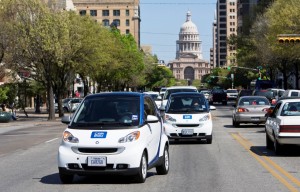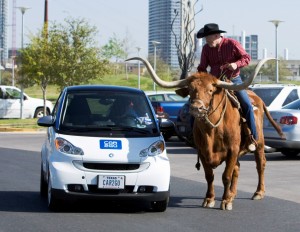
A fleet of Smart fortwo cars will be used by city of Austin employees in the demonstration.
In the unending quest for new markets, automakers are now setting their sights on the very places that car use has made inhospitable – crowded cities. While the approaches take various forms of sharing or renting vehicles, they all have in common the promise of easing urban mobility and eliminating some of the onerous aspects of owning or renting a car in urban areas. In order to make this latest incursion palatable — or at least to deflect some of the obvious criticism that more cars aren’t the answer to making cities more attractive — “green” promises of emission reduction are made, along with more dubious assertions that this can actually reduce congestion. Still, the idea is attractive enough to explore further.
Just announced in Austin, Texas, this morning is a partnership between the city government and Daimler that will see a demonstration fleet of 200 Smart fortwo cars in service this fall. This “car2go” program emulates as similar demonstration project that started last fall in the much smaller German City of Ulm. Coincident with the Austin announcement, the Ulm program is being expanded today so that the public can participate and not just a select group of Daimler employees. At its start the Austin program, too, is only available to city employees.
The car2go concept is based on a fleet of Smart fortwo vehicles, which are available for rent to registered members at any time. Daimler claims that this makes city driving “as easy as using a mobile phone.”
Unlike some car-sharing programs, car2go promises you can get in a car and drive at any time of day without reserving in advance. The vehicle can then be used for as long as required and returned to any available parking location within a defined area of operation. Critics of similar car sharing programs, such as Massachusetts based Zipcar which operates in a dozen university cities, say that once a program becomes popular, availability becomes restricted and convenience turns to hassles. Major rental companies including Hertz and U-haul are also looking at the idea. Daimler is taking this slowly with a controlled test group of city employees. It will then be extended to the public, if it’s successful.
“Our project in Austin is the next logical step,” said Thomas Weber, who is responsible for Group Research and for Development of Mercedes-Benz Cars. The car-sharing market in the U.S. is enjoying the highest growth rate in the world, according to Daimler.

Howdy pardner, want to share my ride?
The goal of the Austin pilot project is to gather practical experience toward the international implementation of car2go. Challenges for the Germans include its transferability to other cities, languages and mobility trends, as well as the adaptation of its business processes to the legal requirements that exist in different countries.
The car2go project in Austin includes not only the vehicles, but also the associated personnel and technical infrastructure will be provided by Daimler.
With today’s start of the public test phase in Ulm, car2go is now available to all 120,000 citizens and visitors. The vehicle fleet is being increased from its initial 50 cars to 200. Daimler says 1,000 potential drivers have registered.
The way the program works in Germany requires a one-time registration. The car2go customer receives a membership card with an electronic identifier that that will unlock the vehicle. Customers then can use the vehicle in a number of different ways. Vehicles can be rented on the spur of a moment or reservations made up to 24 hours in advance, with customers being notified via text message about the location of the reserved car. Vehicles can also be located on the internet or through the car2go service hotline. Rates are by the minute, hour, or day. Pricing is all-inclusive — taxes, insurance, miles and gas.
As part of the strategy, car2go will not only expand internationally, but also focus more heavily on larger city areas. Austin is six times larger than Ulm in terms of its population and its geographical size.
“We conceived car2go for international implementation from the very beginning,” explains Robert Henrich, the project leader. “With the positive experience that we have gathered in Ulm so far, we are now focusing on the challenges and opportunities presented by larger cities.”
It will be interesting to see how this eventually unfolds in Austin. Public-private partnerships raise antitrust, conflict of interest, and the “use of public money to foster private profit” issues in the U.S. To be successful there needs to be a “critical mass” of cars available so that the on-demand promises are kept. This in turn means adding cars, potentially increasing congestion and pollution, no matter how small or how clean those cars are. And to reach this critical mass are public servants willing to restrict other companies from doing the same or similar things? And will they grant privileged parking or privileged road access to one class of vehicles or users? Good questions all; ones that TheDetroitBureau.com intends to actively pursue.
